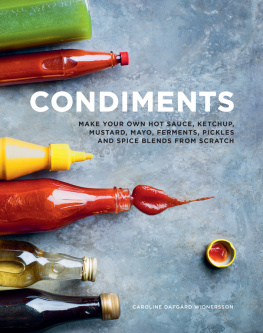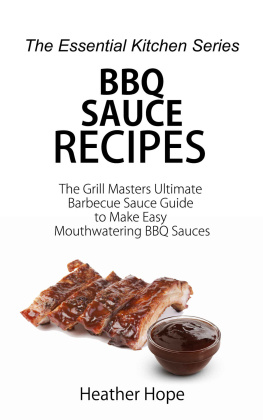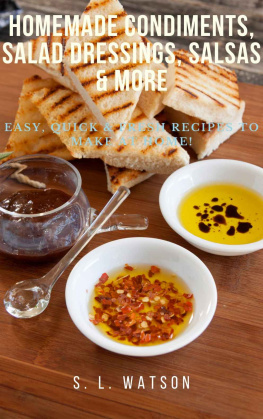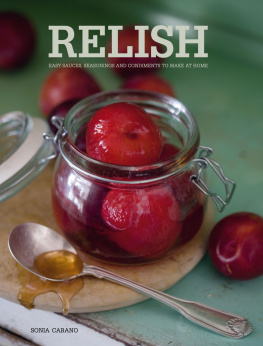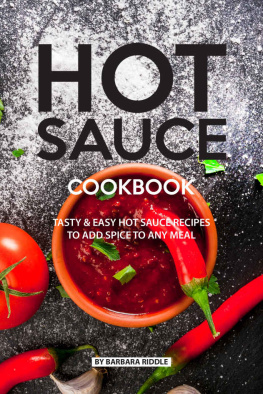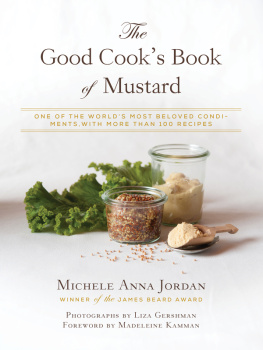Once youve tasted fresh, delicious homemade condiments, where youre in charge of the flavour profile, youll never go back to store-bought. Too often, commercial versions are loaded with extra salt, sugar, allergens and preservatives, and can taste bland and uninspiring. Why not make your own? From ketchup, sweet chilli sauce and taco seasoning to peppery American hot sauce, sizzling Tunisian harissa and tangy Dijon mustard, as well as infused vinegars, aromatic spice blends, pickles and preserves, here are more than 90 simple recipes that show you, step by step, how to make your own condiments from scratch by boiling, blending, mixing, fermenting and aging.
This book is a love song to condiments and the joy that making them brings. Start making your own delicious accompaniments, and that weeknight stir-fry will taste so much richer with your homemade oyster sauce, and your tacos even more mouth-watering when paired with the hot sauce youve fermented at home.
CAROLINE DAFGRD WIDNERSSON is a chef and food stylist whose clients range from large food companies to Swedens premier food magazines.
AGAINST DRY AND BORING FOOD
Ive been interested in preserved flavours for as long as I can rememberpickling, juicing, drying, and conserving are just a few of my secret hobbies. Flavours that have been harnessed and somehow tinned, poured into a bottle, or preserved in a jarthats what this book is about. For more than a year Ive been mixing and blending, boiling and roasting, canning and fermenting. Ive found sriracha on my ceiling after the explosion of an overly potent bottle. Ive fought a war against an army of uniquely stubborn fruit flies in the heat of summer. And Ive lovingly fed vinegar mothers like they were my own children. All this to find the best homemade condiments. This book is a love song to these flavourful accompaniments, and a crash course in making them yourself.
You might ask why you should spend a bunch of time making your own condiments. Let me tell you: Your weeknight stir-fry will taste better with homemade oyster sauce, your burger will be more delicious with your own ketchup, your oysters will be that much fancier paired with hot sauce that youve fermented yourself. Store-bought condiments, especially for the Asian kitchen, tend to have a lot of additives. If youre no friend of MSG (monosodium glutamate) you have one more reason to make your own sauces and spice blends.
Many of the recipes in this book have innumerable variations, and the original formulas are often top secret. My recipes are interpretations of more or less well-known condiments, adapted to suit the home kitchen and using ingredients you can find in your local grocery store.
Part of the fun of making your own condiments is that youre in charge of their flavour profile. These recipes should serve as a guide for your experiments in finding your own favourite combinations. If you like spicy food, use an extra-hot chilli variety in your hot sauce. If you prefer your ketchup on the sweeter side, add more sugar.
Most recipes in this book are pretty straightforward. Some of them require a bit more time, and others ask for unusual ingredients. But whats great is that the cooking time tends to reflect shelf lifeif you spend a long time making it, you can enjoy it for longer, too. Exactly how long is impossible to say, and I wont be able to give you any precise best before dates. Youll have to trust your own senses: Look, sniff, and taste. If it looks good and smells fine, its generally safe to eat.
If youre only planning to make one thing from this book, then head straight to the !
Good luck!
Caroline
MUSTARD,
KETCHUP
AND MAYO
Mustard, ketchup and mayonnaise are three of the most common kitchen staples. You could call them the holy trinity of condiments. Youll find them in even the saddest of fridges, perhaps sitting next to a jar of pickles or an old taco salsa.
They are both easy to make and easy to use. Think of these three staples as the gateway to making your own condiments: you wont need any unusual ingredients or tools, and there are plenty of ways to use them.
Most of us probably have some sort of relation to ketchup. I remember when I was a kid and me and my siblings would always get a hot dog with Slotts brand ketchup during our Saturday outings. I loved that ketchupit was what made the hot dog. It was sweeter and more tomatoey than the ketchup we had at home. Nowadays I prefer mustard on my sausage. Ideally a sweet and spicy mustard on two Stockholm-style sausages, and a fried egg. Pair it with a small beer, and youve got the perfect Saturday lunch.
And mayonnaise, the queen of emulsions. It amazes me each time that the right whisking technique can turn egg yolk, mustard, vinegar, and oil into silky smooth mayonnaise. But be too impatient with the oil and youll end up with a greasy, yellow mess thats all but appetising.
MUSTARD, KETCHUP AND MAYO
- Roasted cherry tomato ketchup
- Traditional chilli sauce
- Traditional ketchup
- Tomato paste
- Curry ketchup
- Traditional mayonnaise
- Japanese mayonnaise
- Dijonnaise
- Egg-free avocado mayonnaise
- Soy-sauce mayonnaise
- Dijon mustard
- Wholegrain mustard
- American mustard
- Sweet and spicy mustard
MUSTARD
Mustard is one of the worlds oldest condiments. In its most basic form, its made by mixing ground mustard seeds with some type of liquid. Roughly speaking there are three types of mustard seeds: yellow, brown, and black. The yellow seeds have a milder flavour and are actually not that closely related to the brown and black types, which are more peppery. Historically, black mustard seeds have been used in most types of mustard, Dijon in particular. But black seeds are difficult to harvest, and as a result brown mustard seeds are increasingly used in their place. American mustard, however, is made from yellow mustard seeds.
Crushed mustard seeds release enzymes which produce that hot flavour when they come into contact with water. The reaction lasts no longer than ten minutes, after which the enzymes begin to break down, sometimes creating a bitterness. Adding wine or vinegar slows down and stabilises the reaction and allows us to harness the lovely peppery mustard flavour. If youre not a fan of hot mustard I recommend heating it up. This causes the enzymes to break down, immediately mellowing the mustard. Its also the reason why you should only add mustard at the end when cooking stews and sauces.

